Chapter 27 Subjects Emf devices (review) Resistors in series and parallel Power (examples)
advertisement
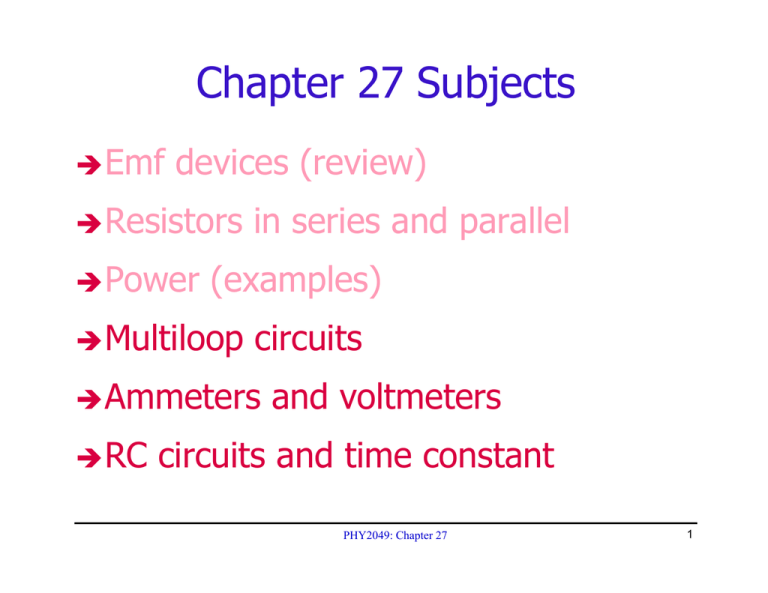
Chapter 27 Subjects Î Emf devices (review) Î Resistors Î Power in series and parallel (examples) Î Multiloop circuits Î Ammeters Î RC and voltmeters circuits and time constant PHY2049: Chapter 27 1 More Complicated Circuits (More than one battery, not bundled) ÎParallel ÎUse and series rules are not enough! Kirchhoff’s rules 9V 22 Ω 15 Ω 6V 8Ω PHY2049: Chapter 27 2 Kirchhoff’s Rules ÎJunction ÎLoop rule rule Example a a V1= iR1 ℇ a V2= iR2 iR1 ℇ iR2 ℇ – iR1 – iR2=0 Analogy: battery=pump, resistors=narrow tubes, potential=water pressure. PHY2049: Chapter 27 3 Kirchhoff’s rules ÎDetermine the magnitudes and directions of the currents through the three resistors in the figure below. Take two loops, 1 and 2, as shown Junction rule: I1 + I2 through 8 Ω b 22 Ω Loop rule: 9V I2 a ->a 6 – 8(I + I ) – 15I =0 1 2 1 2 b ->b 9 + 15I1– 22I2 =0 I1 15 Ω a 6V I1+I2 1 8Ω I1= 30/313 = 0.096 A I2= 297/626 = 0.474 A I1+ I2= 357/626 = 0.570 A PHY2049: Chapter 27 4 Multiloop Circuit ÎWhich shown? of the equations is valid for the circuit 1Ω (a) 2 – I1 – 2I2 = 0 (b) 2 – 2I1 – 2I2 – 4I3 = 0 (c) 2 – I1 – 4 – 2I2 = 0 (d) I3 – 2I2 – 4I3 = 0 (e) 2 – 2I1 – 2I2 – 4I3 = 02 V I2 4V I1 1Ω PHY2049: Chapter 27 2Ω 6V I3 3Ω 5 Deceptively Simple Problem ÎFind Req of the resistance network shown This network cannot be broken down into parallel and series resistors. (Try and convince yourself) Must use Kirchhoff’s rules. That requires adding a battery, 10 kΩ which drives current through 3 kΩ the network. 10 kΩ Req then means I ℇ network 10 kΩ 10 kΩ ℇ = I Req I So find I, for given ℇ. PHY2049: Chapter 27 6 (continued) ÎKirchhoff’s rules junction rule, reduce the number of unknown currents to 3: for instance i1, i2, i. Choose 3 loops and apply loop rule to them. ℇ -i2R2-iR+i1R=0 R=10 kΩ R2=3 kΩ Using R2 i2 i1 R i R -(i2-i)R+(i1+i)R+iR=0 i2–i ℇ-i2R2-(i2-i)R=0 Solve for i1, i2, i i=ℇ(R-R2)/(3R+5R2)R i1=ℇ(R+3R2)/(3R+5R2)R R 1 2 R i1+i i2=ℇ 4/(3R+5R2) PHY2049: Chapter 27 7 (continued) the total current I into, and out of, the network is i1+ i2. So ℇ = (i1+i2)Req Substitute: ℇ ℇ = ℇ (5R+3R2)/(3R+5R2)R * Req i1+i2 Note: Req= (3R+5R2)R/(5R+3R2) =450/59=7.63 kΩ R R2 i2 i1 R i R R i2–i i1+i i1+i2 PHY2049: Chapter 27 8 Problem Solving Using Kirchhoff’s Rules ÎLabel the current in each branch of the circuit Choice of direction is arbitrary Signs will work out in the end (if you are careful!!) Apply the junction rule at each junction Keep track of sign of currents entering and leaving ÎApply loop rule to each loop (follow in one direction only) Resistors: if loop direction matches current direction, voltage drop Batteries: if loop direction goes through battery in “normal” direction, voltage gain ÎSolve equations simultaneously You need as many equations as you have unknowns PHY2049: Chapter 27 9 Res-Monster Maze (p. 725) All batteries are 4 V All resistors are 4 Ω Find current in R PHY2049: Chapter 27 10 Ammeters and Voltmeters Î Ideal ammeter A Zero internal resistance Î Ideal voltmeter Infinite internal resistance Î Internal V Actual ammeter resistances In ammeter: series with “the ideal ammeter” inside Actual voltmeter the real ammeter In voltmeter: parallel with “the ideal voltmeter inside the real voltmeter PHY2049: Chapter 27 A Ideal ammeter Ideal voltmeter V 11 RC Circuit (Charging a Capacitor) ÎCharging a capacitor takes time in a real circuit Resistance allows only a certain amount of current to flow Current takes time to charge a capacitor ÎAssume uncharged capacitor initially Close switch at t = 0 Initial current: i = E /R (since no charge on capacitor) Initial charge: q = 0 E ÎWhen fully charged Final current: i = 0 Final charge: q = ℇ C PHY2049: Chapter 27 12 (continued) ÎWhat happens in between? Use loop rule: E–iR–q/C=0 ÎCurrent ÎSo and charge are related: i = dq / dt can recast first equation as “differential equation” dq q E E + =E dt RC R ÎGeneral solution is q = EEC + Ke −t / RC (Check and see!) K = −E C (necessary to make q = 0 at t = 0) ÎSolve for charge q and current i dq E −t / RC −t / RC = e q = EEC 1 − e i= dt R ( ) PHY2049: Chapter 27 13 Charge and Current vs Time ( q ( t ) = q0 1 − e −t / RC ) q0: q at t →∞; q0=E C i ( t ) = i0e −t / RC i0: i at t = 0; i0=E /R PHY2049: Chapter 27 14 Exponential Behavior ÎRC is the “characteristic time” of any RC circuit Only Ît t / RC is meaningful = RC Current falls to 37% of maximum value Charge rises to 63% of maximum value Ît =2RC Current falls to 13.5% of maximum value Charge rises to 86.5% of maximum value Ît =3RC Current falls to 5% of maximum value Charge rises to 95% of maximum value Ît =5RC Current falls to 0.7% of maximum value Charge rises to 99.3% of maximum value PHY2049: Chapter 27 15 Discharging a Capacitor ÎConnect =0 V +q –q ÎSolve fully charged capacitor to a resistor at t S C R i dq q + =0 dt RC for charge q ÎDifferentiate –iR–q/C=0 q = q0 e − t / RC to find current i q0 −t / RC V0 −t / RC dq i= =− e =− e dt RC R PHY2049: Chapter 27 16 Charge and Current vs Time q ( t ) = q0e −t / RC q0: q at t = 0; q0=V0C i ( t ) = i0e −t / RC i0: i at t = 0; i0=−V0/R PHY2049: Chapter 27 17 Energy Consideration ÎEnergy initially stored in the capacitor (Sect. 25-5) U = q02/ 2C q0: q at t = 0; q0=V0C ÎEnergy dissipated (converted to thermal energy) at the resistor −t / RC i : i at t = 0; i =−V /R i t =i e 0 0 0 () Integrate 0 P=i2R from t=0 to ∞ to find U = (i02R) RC/2 = [(q0/RC)2R] RC/2 = q02/2RC Agrees with energy initially stored in capacitor. Confirms conservation of energy. PHY2049: Chapter 27 18



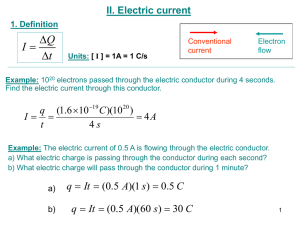
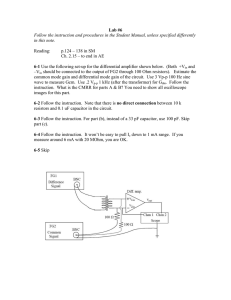

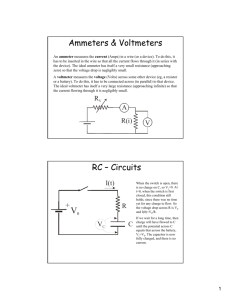
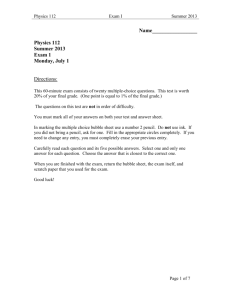
![Sample_hold[1]](http://s2.studylib.net/store/data/005360237_1-66a09447be9ffd6ace4f3f67c2fef5c7-300x300.png)